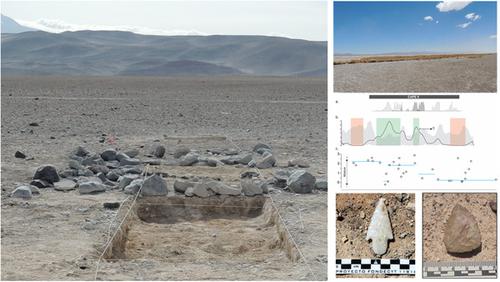当前位置:
X-MOL 学术
›
Geoarchaeology
›
论文详情
Our official English website, www.x-mol.net, welcomes your
feedback! (Note: you will need to create a separate account there.)
Late Pleistocene–Early Holocene human settlement and environmental dynamics in the southern Atacama Desert highlands (24.0°S–24.5°S, Northern Chile)
Geoarchaeology ( IF 1.4 ) Pub Date : 2021-02-21 , DOI: 10.1002/gea.21849 Patricio Souza 1 , Isabel Cartajena 1 , Rodrigo Riquelme 2 , Antonio Maldonado 3, 4, 5 , María E. Porras 6 , Boris Santander 7, 8 , Lautaro Núñez 9 , Laura Díaz 2
Geoarchaeology ( IF 1.4 ) Pub Date : 2021-02-21 , DOI: 10.1002/gea.21849 Patricio Souza 1 , Isabel Cartajena 1 , Rodrigo Riquelme 2 , Antonio Maldonado 3, 4, 5 , María E. Porras 6 , Boris Santander 7, 8 , Lautaro Núñez 9 , Laura Díaz 2
Affiliation

|
The earliest known population of the Atacama Desert coincided with the Central Andean Pluvial Event II (CAPE II), an extensive pluvial event recorded during the Late Pleistocene–Early Holocene (13,800–8,500 cal years BP). A large number of archaeological sites from this period have been found along the borders of the Imilac and Punta Negra (24.5°S) high-altitude basins (ca. 3,000 masl). By combining the results of proxy data obtained from geomorphological, sedimentological, and paleoecological (rodent middens) archives and the spatial location of archaeological sites and radiocarbon series analyses, this paper examines the links between human activities and paleoenvironmental dynamics at different times during CAPE II in the southern Atacama Desert. This is done at a finer spatial and temporal scale than previous studies. The first archaeological sites (ca. 12,000–11,200 cal years BP) are concomitant with increased paleowetland occurrence frequency. An occupational hiatus is recorded between 11,200 and 10,800 cal years BP, synchronous with a drop in precipitation and wetland development. This is followed by a displacement of the archaeological sites toward the south-east of the Punta Negra Basin and concomitant again with a second peak of wetland development in the area (10,800–10,400 cal years BP) before the final abandonment of the salt flat margins.
中文翻译:

南部阿塔卡马沙漠高地(24.0°S-24.5°S,智利北部)晚更新世 - 早期全新世人类住区和环境动态
第一个考古遗址(约 12,000-11,200 卡年 BP)伴随着古湿地发生频率的增加。职业中断记录在 11,200 到 10,800 卡年 BP 之间,与降水和湿地发展的下降同步。随后考古遗址向蓬塔内格拉盆地东南部迁移,并伴随着该地区湿地发展的第二个高峰(10,800-10,400 cal 年 BP),然后最终放弃盐平边缘.
更新日期:2021-02-21
中文翻译:

南部阿塔卡马沙漠高地(24.0°S-24.5°S,智利北部)晚更新世 - 早期全新世人类住区和环境动态
第一个考古遗址(约 12,000-11,200 卡年 BP)伴随着古湿地发生频率的增加。职业中断记录在 11,200 到 10,800 卡年 BP 之间,与降水和湿地发展的下降同步。随后考古遗址向蓬塔内格拉盆地东南部迁移,并伴随着该地区湿地发展的第二个高峰(10,800-10,400 cal 年 BP),然后最终放弃盐平边缘.











































 京公网安备 11010802027423号
京公网安备 11010802027423号